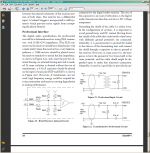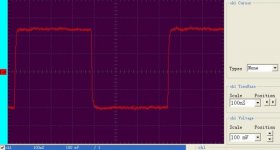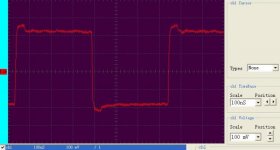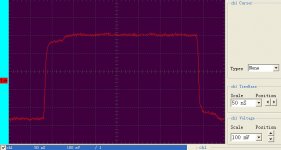Somehow I suspect that if we examine the input circuits of several units, they will diverge quit a bit from a true 75 Ohm circuit
nahh
see apps here
consumer (RCA jack ) uses 75 ohm instead of 110
Attachments
Last edited:
Not quite, 5.6448Mhz is the symbol rate, but we need a reasonable eye pattern to be able to recover the data (much less lock the clock generator up cleanly), still it seems likely that the critical distance is longer then most HIFI wiring (and definitely longer then any reasonable connector).From an old Belden note:
If you go by the 1/4-wave numbers the critical distance (after which the impedance is important to match) is:
44.1 kHz = 5.6448 MHz= 44 ft.
In point of fact, if you source terminate the line then most of the reflected energy will just be absorbed by the source termination, and the only effect of the mismatch will be slightly slower edges at the receiver or slight ISI (Unlikely to be critical given the relatively low data rate).
Regards, Dan.
BNC combination at both ends (that is 4 X BNC) works much better than 4 X RCA. In fact, 4X RCA was completely unpredictable and was changing characteristics (sound) with the tiniest little change in cable length…. Internal wiring (within the transport and DAC) should also be executed with coax cable.
I obtained the best results with 2.5m length of RG6 quad shield cable terminated at both ends with BNC connectors. Much better than anything else I've tried.
Another interesting thing: I use almost exclusive properly annealed pure silver ribbons as power cables, speaker cables and interconnects (and internal hook-up wire!) Sounds detailed and very fast - great for valves.... however, nothing matched RG6, BNC terminated, when it comes to S/PDIF.
It is even more important to properly couple S/PDIF to receiver chip, using adequate PCB layout and adequate circuit / components, but this has been discussed at lengths here as well as "over there"....
Boky
I obtained the best results with 2.5m length of RG6 quad shield cable terminated at both ends with BNC connectors. Much better than anything else I've tried.
Another interesting thing: I use almost exclusive properly annealed pure silver ribbons as power cables, speaker cables and interconnects (and internal hook-up wire!) Sounds detailed and very fast - great for valves.... however, nothing matched RG6, BNC terminated, when it comes to S/PDIF.
It is even more important to properly couple S/PDIF to receiver chip, using adequate PCB layout and adequate circuit / components, but this has been discussed at lengths here as well as "over there"....
Boky
BNC combination at both ends (that is 4 X BNC) works much better than 4 X RCA. In fact, 4X RCA was completely unpredictable and was changing characteristics (sound) with the tiniest little change in cable length…. Internal wiring (within the transport and DAC) should also be executed with coax cable.
I obtained the best results with 2.5m length of RG6 quad shield cable terminated at both ends with BNC connectors. Much better than anything else I've tried.
Another interesting thing: I use almost exclusive properly annealed pure silver ribbons as power cables, speaker cables and interconnects (and internal hook-up wire!) Sounds detailed and very fast - great for valves.... however, nothing matched RG6, BNC terminated, when it comes to S/PDIF.
It is even more important to properly couple S/PDIF to receiver chip, using adequate PCB layout and adequate circuit / components, but this has been discussed at lengths here as well as "over there"....
Boky
And just to toss in a little more silliness, BNC connectors used to be 50 ohm devices. This became an issue when standard definition serial digital video became common in the early 90's and the impedance mismatch with the 75 ohm cable messed up data recovery. I don't know if the 50 ohm connectors are still manufactured but I haven't seen a new one in 20 years in the video industry.
FWIW I spent the last 2 days at work chasing down an impedance mismatch causing data errors in a video router control system It was a 6 foot cable with 50 ohm BNCs and insufficient spring force on the grounds. Ringing like you wouldn't believe but a simple cable replacement and everything is good again.
G²
OK, so enlighten me. How much (or little) can a good listener hear? I don't want to know about that one special guy, that when the planets align can hear all sorts of things. I know that the answer is complex with lots of conditions to deal with.
I remember that old 0.5555Hz jitter sounding pretty nasty!
We (Tentlabs, Grimmaudio) can hear everything around a ps, especially below 10Hz.
We have a new theory about the audibility. It has nothing to do with distortion, but with zero crossing modulation of the signal.
best
And just to toss in a little more silliness, BNC connectors used to be 50 ohm devices. This became an issue when standard definition serial digital video became common in the early 90's and the impedance mismatch with the 75 ohm cable messed up data recovery. I don't know if the 50 ohm connectors are still manufactured but I haven't seen a new one in 20 years in the video industry.
FWIW I spent the last 2 days at work chasing down an impedance mismatch causing data errors in a video router control system It was a 6 foot cable with 50 ohm BNCs and insufficient spring force on the grounds. Ringing like you wouldn't believe but a simple cable replacement and everything is good again.
G²
Yeah, I think it is shear unpredictability of RCA connectors (they are really "nothing" in terms of impedance...) that makes them unusable for this particular application (S/PDIF), so even if you get RCA terminated good-quality coax cable that sounds reasonable on one particular transport / DAC combo, it will sound completely unpredictable with another transport / DAC combo...

Hello Speedskater
It is not an easy problem, today 99.99% of audio system are not optimized. Optimization consist to cancel all source of audio degradations.
Me and everyone coming at home are able to listen difference between RCA and BNC plug. If you want to reach high audio quality level, you must optimize all your setup: audio equipment, acoustic, main power, vibration, and other parameters...OK, so enlighten me. How much (or little) can a good listener hear? I don't want to know about that one special guy, that when the planets align can hear all sorts of things. I know that the answer is complex with lots of conditions to deal with.
I remember that old 0.5555Hz jitter sounding pretty nasty!
It is not an easy problem, today 99.99% of audio system are not optimized. Optimization consist to cancel all source of audio degradations.
Let me speak about some test that me and some friends made on various audio systems. We test many S/PDIF audio cables. The worst of all were hand-made NON 75 ohm cable. Whatever improvement you can do on these cable, results steels poor (hard-core silver, out of price connector...)
All standard 75 ohm cable sounds better than non 75 ohm hand-made audio cable. I agree with you, for a same cable, full BNC gives better results than RCA connector (with or without BNC/RCA adaptor...).
We test some overpriced audiophile cables. I must admit that all these cables gave better results than standard cables. All these cable were RCA plugged. It seems that since impedance cable is 75 ohm, internal and mechanical characteristics, or other parameters, are more important than connector's impedance. Many test were made with Tenlabs CD Drive and Jundac DAC .
All standard 75 ohm cable sounds better than non 75 ohm hand-made audio cable. I agree with you, for a same cable, full BNC gives better results than RCA connector (with or without BNC/RCA adaptor...).
We test some overpriced audiophile cables. I must admit that all these cables gave better results than standard cables. All these cable were RCA plugged. It seems that since impedance cable is 75 ohm, internal and mechanical characteristics, or other parameters, are more important than connector's impedance. Many test were made with Tenlabs CD Drive and Jundac DAC .
Eric, very nice projects 
For Jundac DAC, change those 50R BNC's for 75R BNC's.
If you are using CS8416, please beware of Schmitt triggers on input. They will screw your input signal. Use driver circuit between your input and input of CS8416
Example with Schmitt triggers OFF
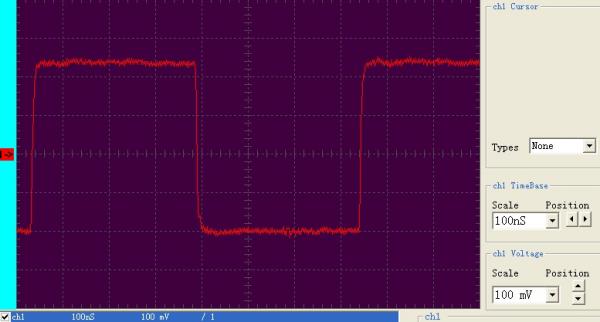
...and with Schmitt triggers ON
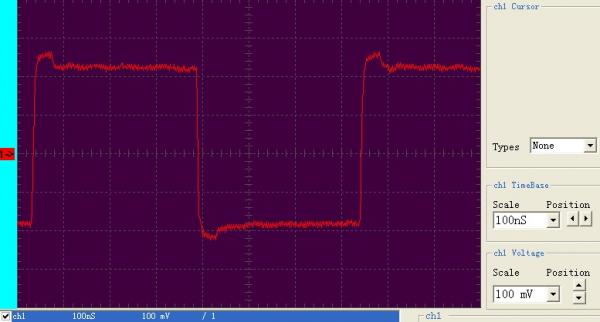

For Jundac DAC, change those 50R BNC's for 75R BNC's.
If you are using CS8416, please beware of Schmitt triggers on input. They will screw your input signal. Use driver circuit between your input and input of CS8416
Example with Schmitt triggers OFF
...and with Schmitt triggers ON
Attachments
I don't see it, the eye pattern will clearly be just fine in both cases and the edges are still plenty fast.
Schmitt is a red herring as far as the edges are concerned (which is what matters for clock recovery in most schemes), so I am far from convinced that it should be making any real difference.
I have to admit to considering all this worry about tiny discontinuities in electrically short SPDIF links to be indicative that someone is not doing their job right when it comes to designing the DAC electronics, clock recovery with low jitter is a solved problem outside the audio world (at least to the point of pushing the jitter down below the converters inherent aperture jitter).
Now maybe there is something magic about audio electronics that I am just not seeing (My background is instrumentation and RF), but a design that needs to sweat ps jitter on a 25Mhz clock is IMHO broken, never mind one that needs to sweat jitter at that level on a 5Mhz biphase stream (Which just speaks of someone making something as simple as possible and then some)!
I would be fascinated to see the phase noise spectrum for a good VCXO marketed for audio to do a comparison with what the RF world considers state of the art.
An interesting approach which would bypass the whole issue of link jitter would be to buffer a seconds worth of bitstream in ram when playback starts then clock it out FIFO fashion, as long as the two clocks were close the seconds worth of buffer would prevent under run if the DAC clock was faster then the transport clock a little extra ram would avoid problems going the other way.
Regards, Dan.
Schmitt is a red herring as far as the edges are concerned (which is what matters for clock recovery in most schemes), so I am far from convinced that it should be making any real difference.
I have to admit to considering all this worry about tiny discontinuities in electrically short SPDIF links to be indicative that someone is not doing their job right when it comes to designing the DAC electronics, clock recovery with low jitter is a solved problem outside the audio world (at least to the point of pushing the jitter down below the converters inherent aperture jitter).
Now maybe there is something magic about audio electronics that I am just not seeing (My background is instrumentation and RF), but a design that needs to sweat ps jitter on a 25Mhz clock is IMHO broken, never mind one that needs to sweat jitter at that level on a 5Mhz biphase stream (Which just speaks of someone making something as simple as possible and then some)!
I would be fascinated to see the phase noise spectrum for a good VCXO marketed for audio to do a comparison with what the RF world considers state of the art.
An interesting approach which would bypass the whole issue of link jitter would be to buffer a seconds worth of bitstream in ram when playback starts then clock it out FIFO fashion, as long as the two clocks were close the seconds worth of buffer would prevent under run if the DAC clock was faster then the transport clock a little extra ram would avoid problems going the other way.
Regards, Dan.
And will a decent receiver chip really have trouble with that little leading bump? It's pretty small.
it won't have any trouble, it will decently translate into jitter
best
OK, can you explain how this translates into jitter? Like Dan, I am under the impression that it's the edge, rising or falling, the makes the difference.
Where do you look to measure the jitter? What is its cause?
I know that this have been covered ad naseum in other threads, but since we are talking about impedance mismatch in cables and connectors, let's talk about how that can cause problems in the receiver circuit and where one would look to measure this problem.
As a long time video tech the problems of bad connectors are obviuos to me, I just look.
But audio is harder.
(might need to split this off into its own thread)
Where do you look to measure the jitter? What is its cause?
I know that this have been covered ad naseum in other threads, but since we are talking about impedance mismatch in cables and connectors, let's talk about how that can cause problems in the receiver circuit and where one would look to measure this problem.
As a long time video tech the problems of bad connectors are obviuos to me, I just look.
But audio is harder.
(might need to split this off into its own thread)
OK, can you explain how this translates into jitter? Like Dan, I am under the impression that it's the edge, rising or falling, the makes the difference.
Where do you look to measure the jitter? What is its cause?
I know that this have been covered ad naseum in other threads, but since we are talking about impedance mismatch in cables and connectors, let's talk about how that can cause problems in the receiver circuit and where one would look to measure this problem.
As a long time video tech the problems of bad connectors are obviuos to me, I just look.
But audio is harder.
(might need to split this off into its own thread)
1) the bump affects the timing of the slope
2) the slope is input for the clock recovery circuit
3) the recovered clock is used for DA conversion
cheers
Hi,
If your analysis is correct,then the triggering is extremely slow, even for CMOS.
Plus, Schmitt Triggers (inside the IC's I know) involve positive feedback, so how can positive feedback lead to attenuation?
While I agree that attaching Schmitt Triggers to a SPDIF input is a bad idea, but I suspect not for the reasons you mention.
BTW, I have had good results with a simple circuits derived from Pat "Jocko Homo" DiGiaccomo's SPDIF input and the circuit Jim Hagerman used in his DAC, plus one or two pieces of my own.
The difference on a 'scope trace on both the spdif line and CS8414 inputs was quite profound, as was the sonic impact.
Ciao T
it is not bump, but rest of the signal that gets attenuated after 40nS because od Schmitt trigers.
If your analysis is correct,then the triggering is extremely slow, even for CMOS.
Plus, Schmitt Triggers (inside the IC's I know) involve positive feedback, so how can positive feedback lead to attenuation?
While I agree that attaching Schmitt Triggers to a SPDIF input is a bad idea, but I suspect not for the reasons you mention.
BTW, I have had good results with a simple circuits derived from Pat "Jocko Homo" DiGiaccomo's SPDIF input and the circuit Jim Hagerman used in his DAC, plus one or two pieces of my own.
The difference on a 'scope trace on both the spdif line and CS8414 inputs was quite profound, as was the sonic impact.
Ciao T
I can understand the need for good vswr up to at least 50MHz, bitclock x 10 is a good start.
I can see how using a schmittt receiver will backdrive the cable - a well designed link should not need schmitt as it, by definition, moves the slicing point away from zero and therefore generates jitter
The RCA is a 40R discontinuity in a 75R line just 100ps long. It can only cause problems with signal content above 1GHz. The receiver and source are going to be anything but 75R at 1GHz. How many designers are using teflon pcb?
I can see how using a schmittt receiver will backdrive the cable - a well designed link should not need schmitt as it, by definition, moves the slicing point away from zero and therefore generates jitter
The RCA is a 40R discontinuity in a 75R line just 100ps long. It can only cause problems with signal content above 1GHz. The receiver and source are going to be anything but 75R at 1GHz. How many designers are using teflon pcb?
How many designers are using teflon pcb?
why would one need teflon ?
best
- Status
- This old topic is closed. If you want to reopen this topic, contact a moderator using the "Report Post" button.
- Home
- Source & Line
- Digital Source
- True 75ohm RCA Type Plug Possible?
